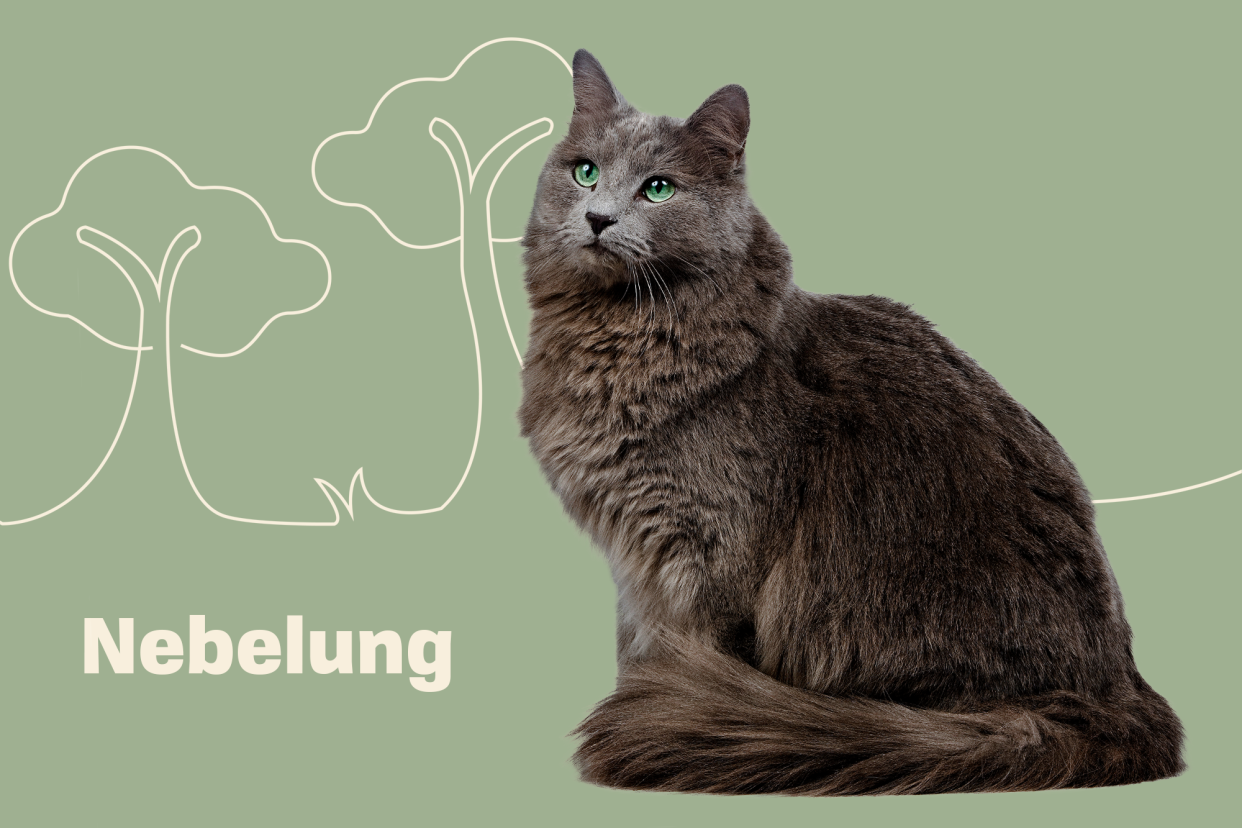Nebelung

Labat-Rouquette/KimballStock
Sometimes mistaken for a Russian blue, the nebelung shares that breed’s long, solid blue coat and approximate size. Indeed, though a genetically separate breed, the Russian blue is still an acceptable outcross for pedigreed nebelungs.
Created in the United States in the 1980s, the nebelung is a rare breed that has become prized for its long, soft coat and understated, mild-mannered personality.
Appearance
Nebelungs have long, graceful necks and torsos, with a modified wedge-shaped head and medium-sized ears. Their almond-shaped eyes are almost always a vivid green, though some examples of yellow-green eyes exist as well.
The nebelung’s coat is medium-long and very soft. Coming in a single color, blue, the coat is usually silver-tipped, especially around the head and neck, giving them a slightly shimmery appearance. Nebelungs have a thicker tuft of hair ringing their necks, which is more pronounced in males. The fur on their tails is longer than that on their bodies, and males and females both have tufted fur between their toes.
Temperament
The nebelung can be an excellent pet for seniors, thanks in large part to his relatively subdued, easygoing personalities. They are quite capable of entertaining themselves and will engage in play throughout the day, but these are cats that are more than happy to sit quietly near their favorite humans or on an available lap.
Nebelungs are not highly social cats, and visitors to the house may not ever see them, depending on how they’re feeling on a given day, but they bond strongly with their family units and are happy to follow their human companions around the house or even ride on a shoulder as you walk.
They do best with adults and older humans and will tend to shy away from smaller children. Similarly, nebelungs get along well with other cats, particularly other reserved breeds, but dogs will be a harder sell and will require more patient introduction and socialization.
The nebelung is a breed that thrives on routine. They appreciate having things in the same place, at the same time each day, particularly feedings. Any changes to their environment or living situation can cause some short-term stress as they take their time to adapt.
Because of their quiet nature, the breed does well on their own, if living in a single pet household or left on their own for extended periods of time. Separation anxiety is rarely an issue for nebelungs, especially if their mealtime structure is adhered to and they have ready access to favorite toys and the litter box.
Living Needs
Happy to be lap cats, nebelungs require very little in the way of special living circumstances. They do well in a variety of temperatures and don’t have a high degree of exercise demands. Once again, however, they do their very best in stable, structured environments. If you’re a person who has a set routine every day, the nebelung will fit into your life very well.
Care
The nebelung’s longer coat will require fairly frequent brushings, probably two to three times a week, to stay looking neat and clean. They are fairly regular shedders, so folks with dander allergies are going to opt for a different breed. As you’re brushing, keep an extra eye on their ears, making sure they’re clean and free of debris, to avoid ear infections.
Health
Because the Nebelung is such a new, rare breed, little is known about potential breed-specific health concerns. They have shown a propensity for obesity as they age, so keeping track of their calorie intake and being judicious with treats will be important. Otherwise, keeping an eye out for common feline issues like Feline infectious peritonitis (FIP), as well as kidney and heart disease, will be the safest course of action as these cats age.
“Around midlife—maybe eight or nine years old—if your vet isn’t already recommending annual blood work (for kidney and heart disease), I’d recommend it,” says Carol Margolis, DVM, DACT of the Gold Coast Center for Veterinary Care on Long Island, N.Y.
“Depending on the cat that you get, if you do something proactive like investing in pet insurance, make sure to look for any breed-dispositions that your insurance won’t cover.”
“Kidney disease is incredibly common (in cats),” Michelle Beck, DVM, CCRT, CVA, of the Backlund Animal Clinic in Omaha, Neb., concurs. “That’s really just across the board in cats. Also, by the age of 10, 70 percent of them have arthritis somewhere in their body. Cats are very good at hiding their pain, so being proactive with your vet is important when it comes to locating and identifying issues.”
History
In 1984, a long-haired blue kitten was born in a litter raised by breeder Cora Cobb of Colorado. The litter parents were a female domestic shorthair and a male long-hair that resembled a black Angora. The kitten, named Siegfried, was the only blue longhair in the litter. The following year, that same pairing produced a second blue longhair: a female Cobb named Brunhilde. It was those two kittens who became the basis for the nebelung breed.
With a breed standard that was originally written with the Russian blue in mind, Cobb set out to create a breed that had a similar coat.
Fun Facts
Nebelungs have been featured in the Animal Planet show Cats 101, and in the animated Pound Puppies & the Legend of Big Paw.
A nebelung was also in the film Garden State, with Natalie Portman and Zack Braff.
On the Harry Potter fandom site Pottermore, a nebelung is one of the animals young wizards can be given as their Patronus.

